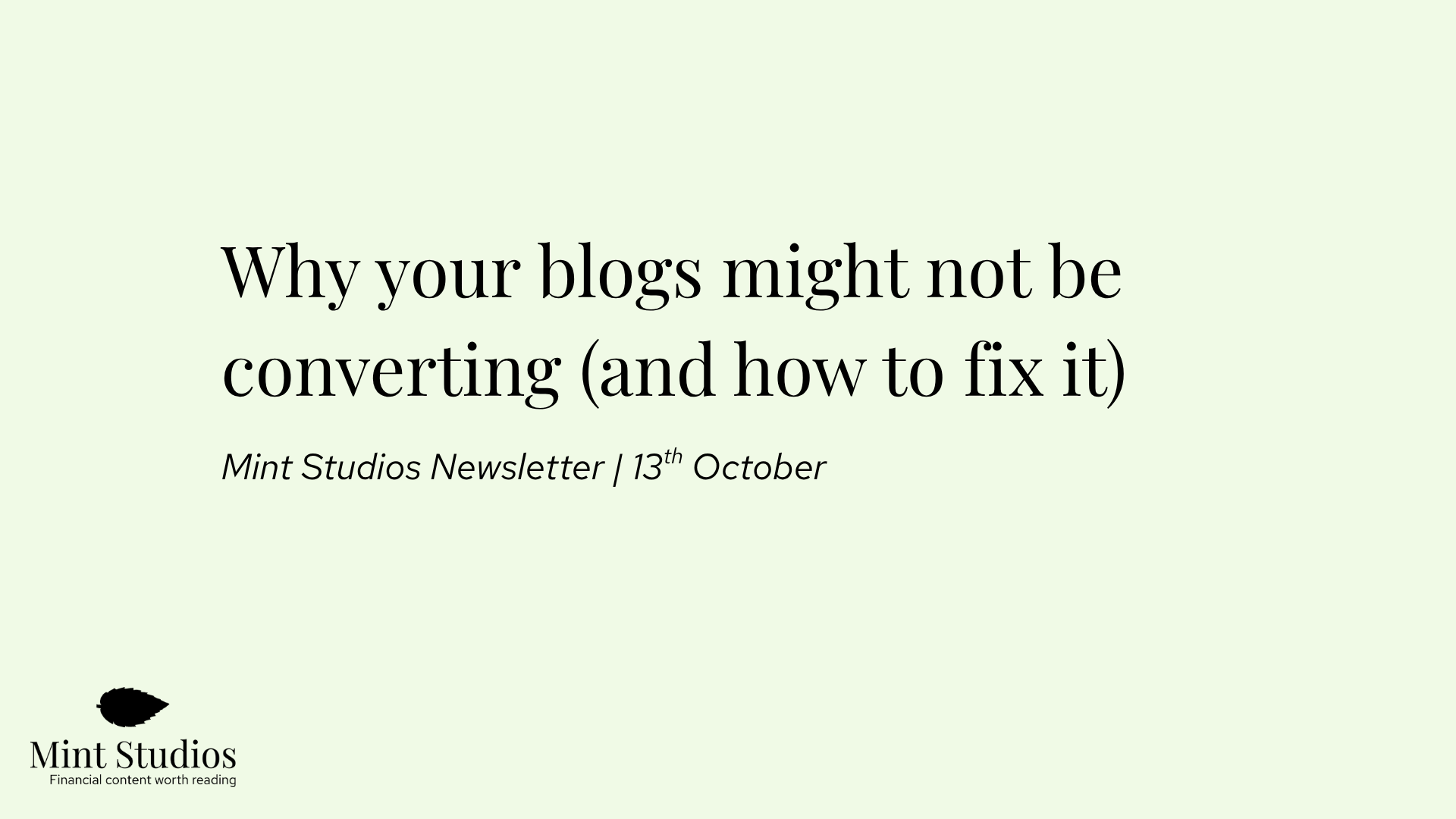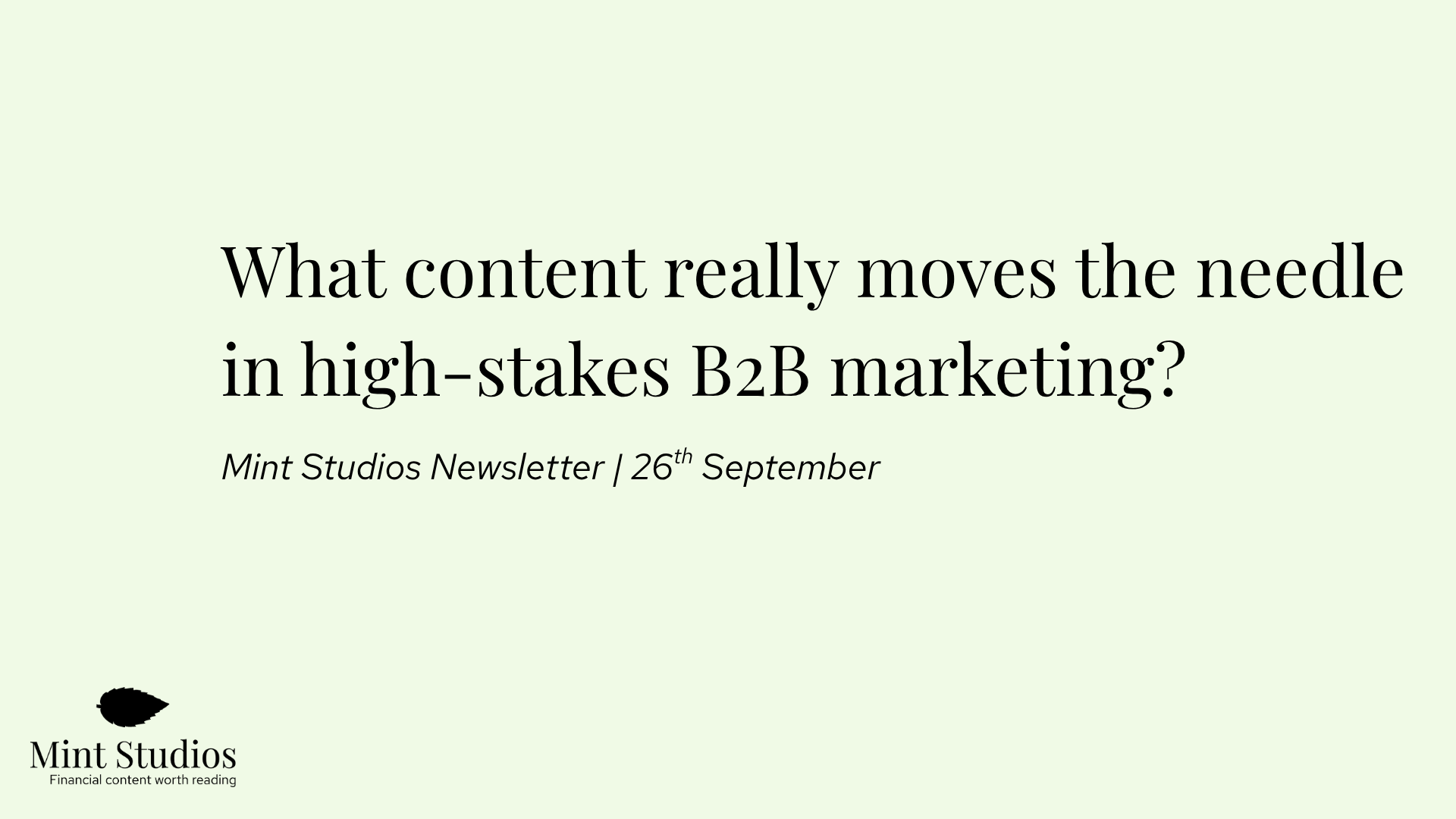Defining what good content looks like is surprisingly tricky. Crucially, good writing and good content are not necessarily the same.
A novel with great writing can entertain and captivate. Yet if we apply the same writing approach to a BOFU blog, we’ll only frustrate our readers.
That’s because when readers are nearing a buying decision, they’re not in the mood for entertainment or clever writing. They simply want their content to:
- Remove uncertainty
- Build confidence
- Present a clear solution
As a content strategist at Mint Studios, I specialise in executing bottom-of-funnel content for fintechs and financial services companies. I’ve seen firsthand what separates content that drives action from content that gets ignored.
In this guide, I’ll show you what effective fintech content looks like with a mix of real and fictional examples.
We’ll examine the specific sections of the typical BOFU blog: the introduction, main body, product section, and closing paragraphs. There’s no magic formula here. But there are patterns and principles that consistently build trust, momentum, and ultimately conversions.
By the end of this article, you’ll have a clearer insight into what a good piece of BOFU content looks like and how to create it.
In this article:
- Why should you create BOFU content?
- Five common mistakes in BOFU introductions (and how to fix them)
- What an effective BOFU introduction looks like
- Four signs that the main body of your article is effective
- What a great production section looks like
- Examples of an effective closing section
Why should you create BOFU content?
Before we get into the specifics of what good BOFU content looks like, let me give you a bit of rationale on why you should create it in the first place. If I’m preaching to the choir, feel free to scroll past!
Bottom-of-funnel (BOFU) content is for people who are close to taking action. They already know what their problem is, and they’re actively looking for a solution.
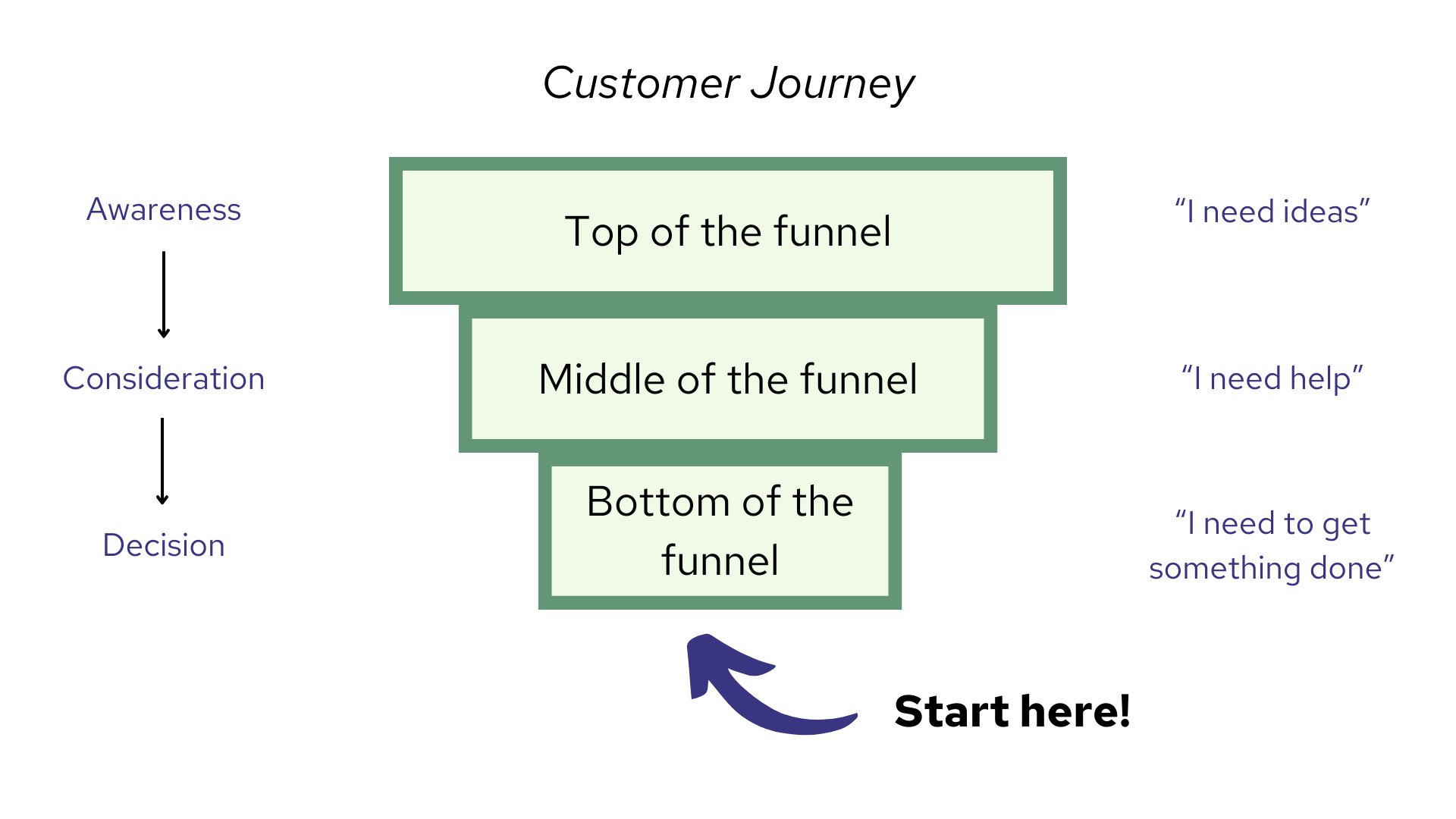
BOFU articles often help potential buyers compare solutions, understand product fit, and take the final step in their decision-making process.
People finding this type of content are prospective customers who have the very problem your product solves; otherwise, they wouldn’t have landed there. No one is reading these blogs for entertainment.
Because they are far down the funnel, these people are serious and ready to convert.
Why invest in BOFU first
To me, it’s a no-brainer to first focus on BOFU. If you’re working to a budget, it’s much better bang for your buck to invest in high-intent BOFU content before going up the funnel.
Here’s an analogy to demonstrate why:
Imagine you own a bike shop.
You could spend your time handing out flyers to people walking through the park, hoping they might one day want a bike to cycle through the park, instead of walking. This is, in essence, TOFU content.
However, you might find that these people are hard to convince. A lot of them aren’t thinking about bikes: they don’t need them for a commute, and don’t do any sports. They’re not your target audience.
So instead of going in blind and trying to convince people that they have a problem, first focus on the people who actually have a problem. Focus on those trying to figure out whether they want a road bike or a mountain bike, or if an e-bike is worth it for them.
Appearing for BOFU keywords is like waving a big sign and inviting those high-intent customers directly into your shop to talk to you. Your blog is like a shopkeeper, explaining the best solution, and getting a sale through building trust and giving valuable insights.
Of course, you can still hand out flyers in the park, but not at the cost of engaging with those high-intent customers.
BOFU content brings in conversions
This isn’t just theory. BOFU content underpins our whole methodology and approach at Mint Studios.
It’s how we’re able to bring in business outcomes with content marketing for our clients. This is how we were able to grow website enquiries by 58% for Fintel Connect, a niche player in the financial services and affiliate marketing space, attracting enterprise customers. It’s also how we helped companies like Jeeves and Zai turn content and SEO into one of their key acquisition channels. You can read more about the results you can get with BOFU content here: Mint Studios Results.
And to learn more about BOFU content and why you ought to invest in it, check out our guide: What is BOFU (Bottom of the Funnel) Content and Why Is it Important?
Five common mistakes in BOFU introductions (and how to fix them)
Mistake #1: It’s too broad or vague and doesn’t empathise with the reader
We’ve all seen intros like this:

This does nothing to earn the reader’s attention. It’s vague, impersonal, and detached from the reason they clicked in the first place.
In BOFU content, this kind of intro fails because it feels generic.
It doesn’t specify who the article is for or what challenges it addresses. It also doesn’t set the expectation particularly well: ‘exploring the power of integrated solutions’ is vague. Is this a buyer's guide? A comparison? It’s unclear.
For a high-intent reader, that’s a red flag: it suggests the content will stay surface-level or repeat what they already know.
What to do instead
Anchor your opening in a specific situation your reader is likely dealing with. Instead of describing a general industry challenge, focus on a concrete, high-pressure decision, such as comparing orchestration providers, replacing a PSP, resolving failed payments, or obtaining a CFO's sign-off on a new integration. Start the piece by naming that scenario outright. The more specific, the better.
Mistake #2: It doesn’t match the reader’s urgency or respect their time
BOFU readers are not browsing. They’re in research mode. They’re actively trying to solve something: remove friction, reduce cost, improve reliability, or validate a product decision.
A vague, slow intro feels completely misaligned with that urgency, and most serious prospects will click away within seconds.
It’s like trying to find a recipe when you’re starving. If you have to scroll through 10 pages on the origins of ‘Teriyaki sauce’ before you get the information you want, you’re probably going to click away.
Example
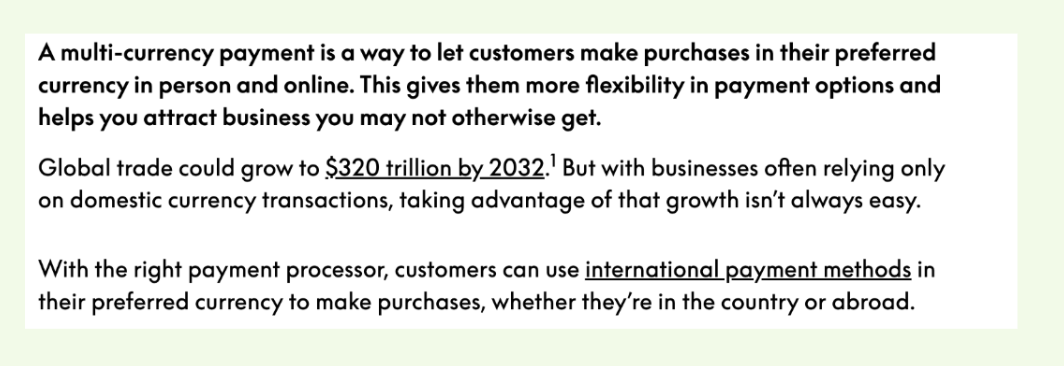
Why this isn’t effective
This intro opens with a dictionary-style definition (“A multi-currency payment is a way to…”), which wastes precious real estate. BOFU readers already know this: they’ve Googled the term, so we can assume they know what it means.
Likewise, the statistic serves little purpose here. If the reader is in this space—which they are, otherwise they wouldn’t have clicked on a BOFU piece—then this is not helpful information for them.
There’s also no pain point here. No sense of urgency. Nothing about what makes multi-currency payments hard, or what risks or inefficiencies come from doing it wrong.
How to fix it
We can improve this intro by putting ourselves in the shoes of our reader and understanding what they want to read.
To illustrate, here’s how we can improve this introduction by emulating our earlier examples of an ‘effective’ introduction.
“If you’re a merchant expanding into new markets, [spelling out who this is for], offering multi-currency payments is critical. Without it, you’re forcing customers to pay in unfamiliar
currencies, hurting conversion rates and creating friction at checkout [highlighting the importance of a solution].
But enabling local currencies at scale comes with real operational challenges [spelling out the pain points] :
- FX markups eat into your margins and vary wildly across providers
- Reconciliation gets messy, especially when settlements land in multiple currencies
- PSP support is inconsistent, with limited tools to manage currencies dynamically
- Customer experience suffers when pricing feels unpredictable or unfamiliar
This article breaks down how to approach multi-currency payments in a way that works for your customers and your operations. This article will help you if you’re a marketplace, a global SaaS platform, or an ecommerce brand scaling internationally. We’ll walk through key decisions, common pitfalls, and what to look for in a provider.”
Mistake #3: The intro doesn’t identify or effectively express the pain points
If you don’t name the pain the reader is feeling or the risk they’re trying to avoid, they have no reason to keep reading. Broad statements about growth or innovation don’t cut it. BOFU readers are looking for answers to specific problems, not inspiration.
Example
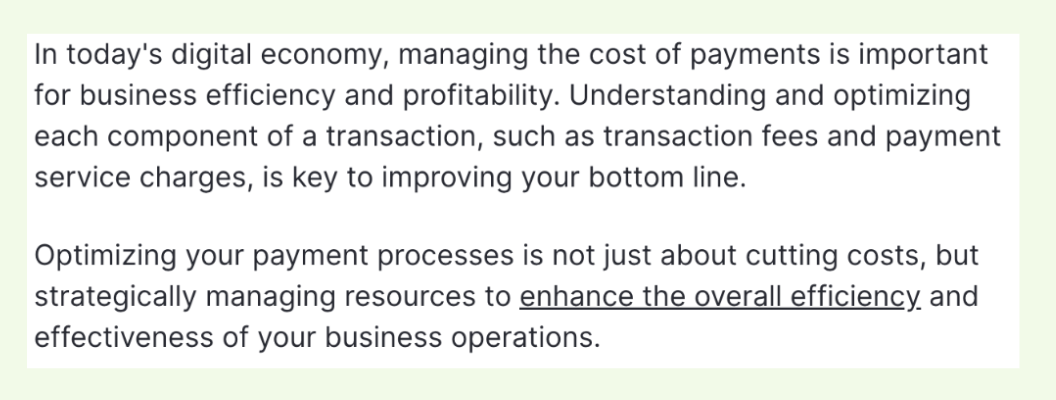
How to fix it
Lead with the specific consequence your reader wants to avoid.
Not “scaling is hard,” but “payment failures are spiking and costing you revenue.”
Not “compliance is complex,” but “you’re operating blind on KYB risk without real-time data”.
You need to show you’re addressing a real-world blocker that’s already on their mind. That’s what earns the right to talk about your solution later.
A better version of this example
If you’re managing payments at scale, you’ve likely felt the impact of rising costs. Transaction fees, platform charges, fraud losses, and chargebacks all chip away at your margins — often in ways that are hard to spot until they’ve added up. [Leads with a real-world consequence and pain point]
The challenge isn’t just knowing you’re overspending. It’s knowing where, why, and how to reduce costs without disrupting payment performance or customer experience. [Names the blocker, acknowledges tension]
This article walks through practical ways to identify inefficiencies in your payments setup, improve visibility, and take back control of your transaction costs. [Sets clear intent and value for the reader]
Mistake #4: It’s written for everyone, and ends up reaching no one: it doesn’t address your audience
This is one of the most common structural failures in BOFU content: trying to write an intro that appeals to as wide an audience as possible. It’s usually done with good intentions, to showcase flexibility, avoid alienating non-core readers, or satisfy stakeholders who want “broad market appeal.” But in reality, it creates the opposite effect. It weakens the message.
At the bottom of the funnel, specificity beats inclusivity every time. The reader is asking: “Is this for me?” If they don’t get a clear “yes” within a few lines, they’ll leave.
For instance, an ineffective piece of content might say:
“Scaling platforms need reliable, flexible infrastructure to support their growth journey. A modular payments stack helps platforms at every stage achieve success.”
This says nothing about the reader’s actual business model, goals, or pain points. This is hollow.
It avoids:
- Naming the actual vertical (e.g. SaaS platforms, vertical software, crypto exchanges)
- Mentioning specific friction points (e.g. split payments, merchant onboarding, FX risk)
- Indicating the buyer’s decision stage (e.g. platform evaluation, vendor migration)
How to fix it
Make a decision about who the piece is for, and say so explicitly, right away.
That might mean opening with:
“If you’re a SaaS platform onboarding multiple merchants each week, you’ve probably outgrown your current PSP’s built-in tools.”
When a reader sees their exact context reflected back at them, they feel understood. They’re far more likely to trust that the rest of the article will be useful and relevant. That trust is what turns readers into customers. Spelling this out also helps LLMs (like ChatGPT) use your content as a source for the right audience, which can potentially increase your brand's visibility on these tools.
It also helps filter out irrelevant readers, which is exactly what you want. BOFU content isn’t meant to attract everyone. It’s designed to influence those who are already close to making a decision.
Don’t be afraid to call out the audience, the vertical, or the specific product limitation the piece addresses. That level of precision signals confidence, experience, and clarity: three things buyers value when they’re about to spend money or make a recommendation.
Mistake #5: It introduces product-specific features too early: earn their trust first
Talking about your product features is great (keep reading to learn more about how to do it effectively). But in the introduction stage, you want to avoid talking too much about what your solution does.
Take this example:
“Our orchestration platform supports 120+ payment providers, with real-time routing, failover logic, and multi-currency support, all through a single API.”
That’s a strong value prop, but it doesn’t belong in your introduction.
At the bottom of the funnel, your reader isn’t asking “What do you do?” They’re asking: Can you solve my problem, and do you understand what I’m dealing with? This kind of intro skips that entirely. It dives straight into product features before building any relevance, trust, or context.
It fails because:
- It doesn’t explain why any of these features matter. The intro lists capabilities but offers no sense of the real-world problems they’re designed to solve. Your reader understands the problems, but you need to educate them on the capabilities and features that solve the problem. If they knew that already, they probably wouldn’t be here.
- It feels like a pitch. You have not earned the right to sell yet. Starting with features reads as self-promotional, not helpful. It puts your company first when the reader needs to see themselves first. There’s a chance your reader thinks that this piece is too biased, and clicks away.
How to fix it
Don’t mention your product in the intro (except in the call to action). You can allude to the possible solutions, but be clear that you’ll educate the reader on it.
For instance:
“Payment orchestration can help to solve all of the above issues. This article will explain how it works and how to choose a provider.”
What an effective BOFU introduction looks like
The introduction is arguably the most important part of any piece of content, whether it's a BOFU or not. It’s where your reader either understands that they’re in the right place or clicks away from your site.
Your reader wants to know:
- Is this relevant to me and my business?
- Can this actually solve my problem?
- Will reading this save me time in the buying process?
Real examples of an effective introduction (and why it works)
Example 1
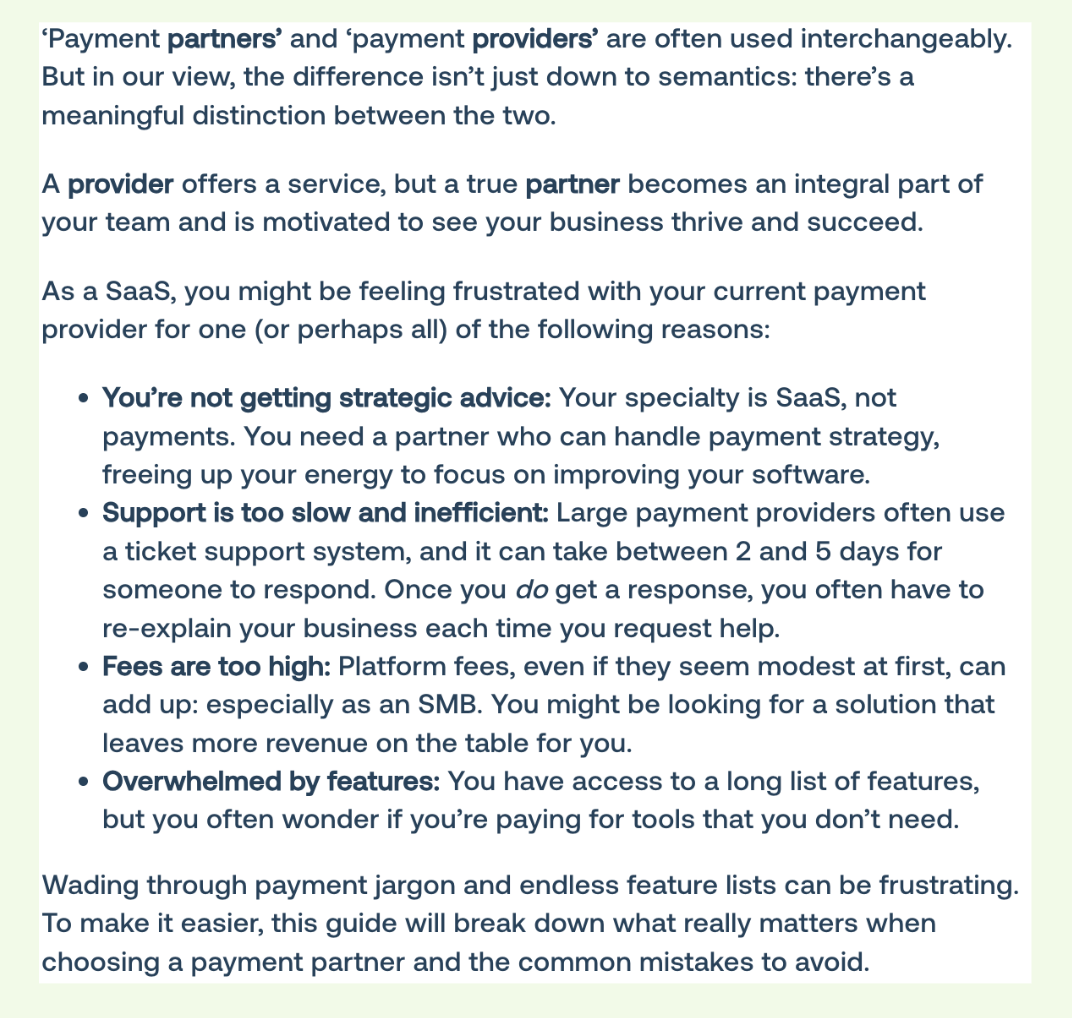
Example 2:
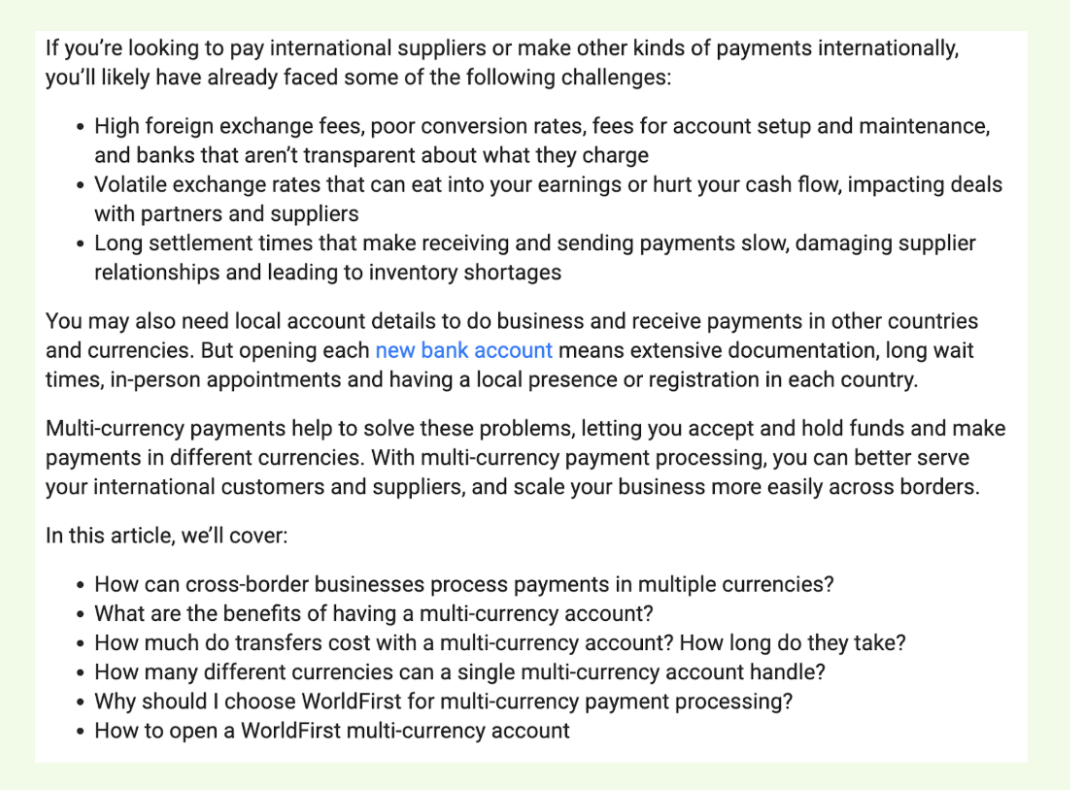
Why these examples are effective
- They open with the reader’s lived reality. There’s no unnecessary scene-setting or backstory, just straight to the problems. That tells the reader this piece understands the world they operate in and isn’t going to waste their time.
Remember, the reader has researched this keyword: so by virtue of ending up here, we can deduce what they already know. We don’t need to give them a quick primer on the landscape of payments.
- It creates trust by being specific and unsentimental. The language is direct and commercial, not dramatised. These aren’t abstract concerns but are plausible events the reader will likely have already experienced (or is actively trying to avoid).
- It signals depth without needing to mention features. There’s limited reference to the solution at this stage. The content earns attention by demonstrating an understanding of the problem space, rather than by pitching a solution.
- It sets a clear, useful intention. The final lines in both examples set an expectation and make a clear promise about the value of reading on. This is important for respecting your audience. If this isn’t what they’re looking for, that saves their time: they weren’t going to convert anyway.
Four signs that the main body of your article is effective
Let’s move on to the main body of the article.
Clearly, there’s no single way to write the “meat” of a BOFU piece, and trying to give a universal example isn’t all that helpful.
However, in our experience, there are a few key characteristics we see time and time again in strong BOFU content across fintech and financial services.
These aren’t rules. But if your content does the following in the body of the article, it’s probably effective:
1. It builds empathy by reflecting the reader’s real challenges
Effective BOFU content doesn’t just talk about generic industry trends: it speaks to the lived reality of the person reading it. That means clearly articulating the specific problems they’re dealing with, in their language.
Good content builds empathy by first naming the pain the readers are feeling, the pressures they’re under, and the blockers that make solving it harder than it sounds. Done well, this creates trust and sharpens the stakes, making the reader more open to your solution.
Example:
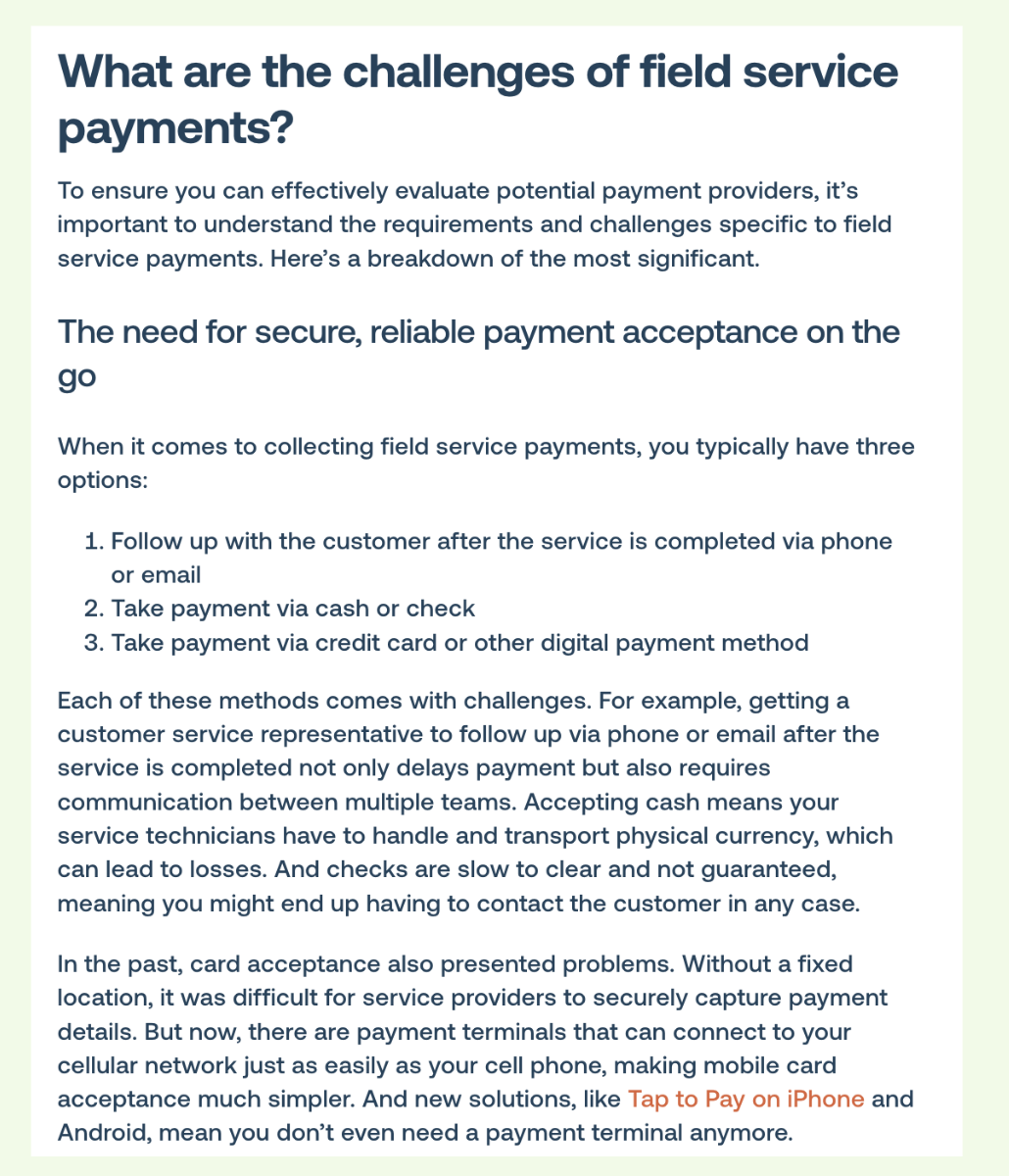
Why it works
- It names the reader’s situation and risk profile. This isn’t “some merchants struggle with payments”. It’s directly calling out crypto, iGaming, travel, etc. That signals relevance within seconds.
- It surfaces operational pain with specificity. Rolling reserves are mentioned, along with the actual pain they cause the reader (cash flow impact is explained). That kind of practical detail and specificity builds credibility.
- It introduces high-stakes consequences. Rather than abstract “disruption,” the example outlines the real business risk of a PSP cutoff and makes the reader picture it happening to them.
- It speaks to the reader’s role. Our reader for this example is likely the head of payments. As such, this content is written to their level and speaks directly to their responsibilities and what could go wrong under their watch.
2. It signals relevance with real use cases
An effective BOFU article makes the reader feel recognised. That doesn’t just mean naming their vertical: it means showing that you understand the specific problems they’re trying to solve.
Use cases are a simple but powerful way to do that. They connect common challenges to practical outcomes, helping the reader see themselves in the content. Without needing a hard sell, they show what solving the problem could look like, and create a natural path to introducing your product later.
Example:
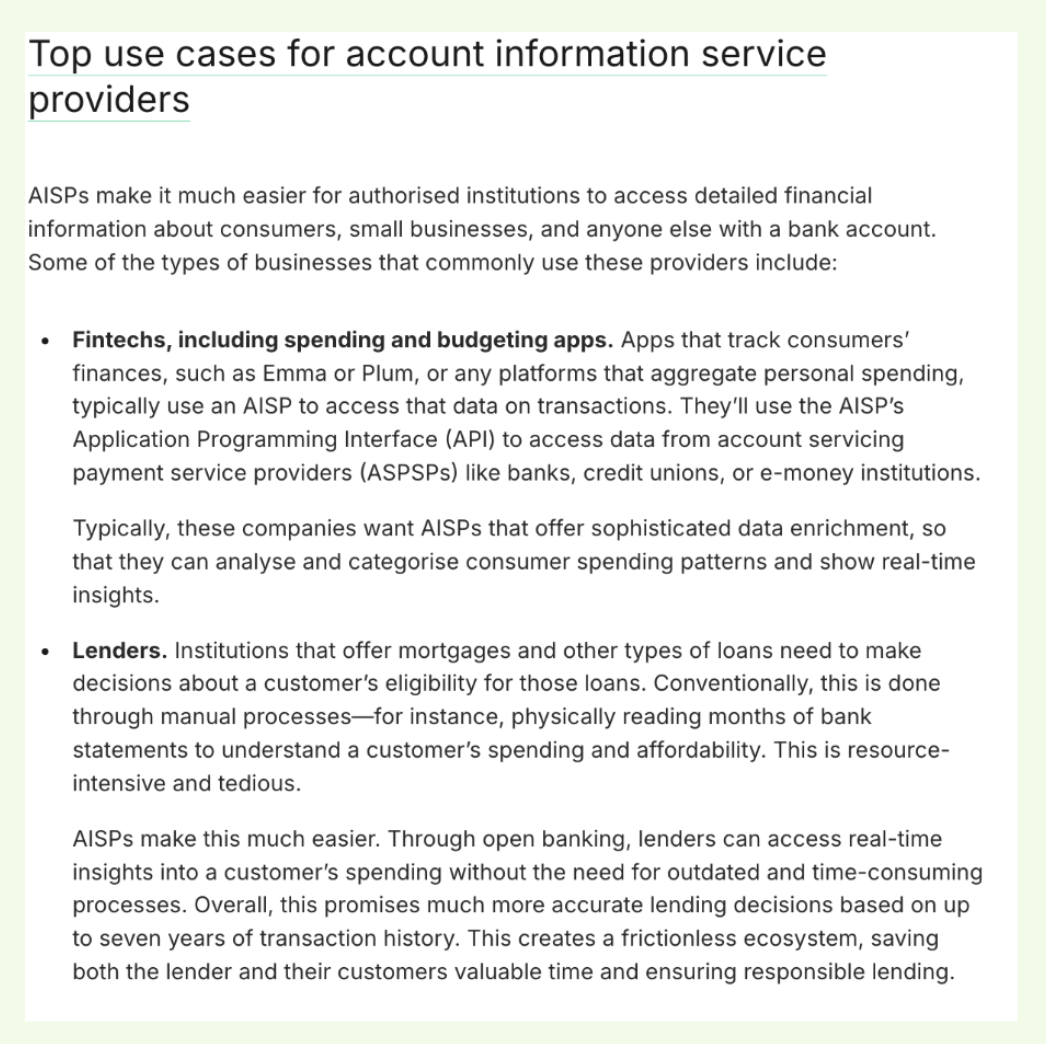
Why it works:
- It spells out the outcome clearly: faster, more accurate lending decisions, without needing to pitch the product directly
- It connects a familiar pain point (manual review of PDFs) to a concrete, modern solution (automated access to real-time data)
- It bridges the gap between concept and business impact, showing how tech leads to efficiency, reduced risk, and a better customer experience.
- It strikes the right balance of terminology: not overly technical, but specific enough to be credible for a fintech-savvy reader
3. It outlines the solution landscape before introducing your product
Strong BOFU content doesn’t rush to talk about your product. Instead, it shows the reader how others solve similar problems and helps them understand the broader landscape.
By doing this, you create space for the reader to think critically about their needs. It shows that you’re here to help them make a smart decision, not just sell your solution.
Once they understand the wider strategy of how to fix their problem, the reader will be more receptive to seeing how your product fits into it.
Example
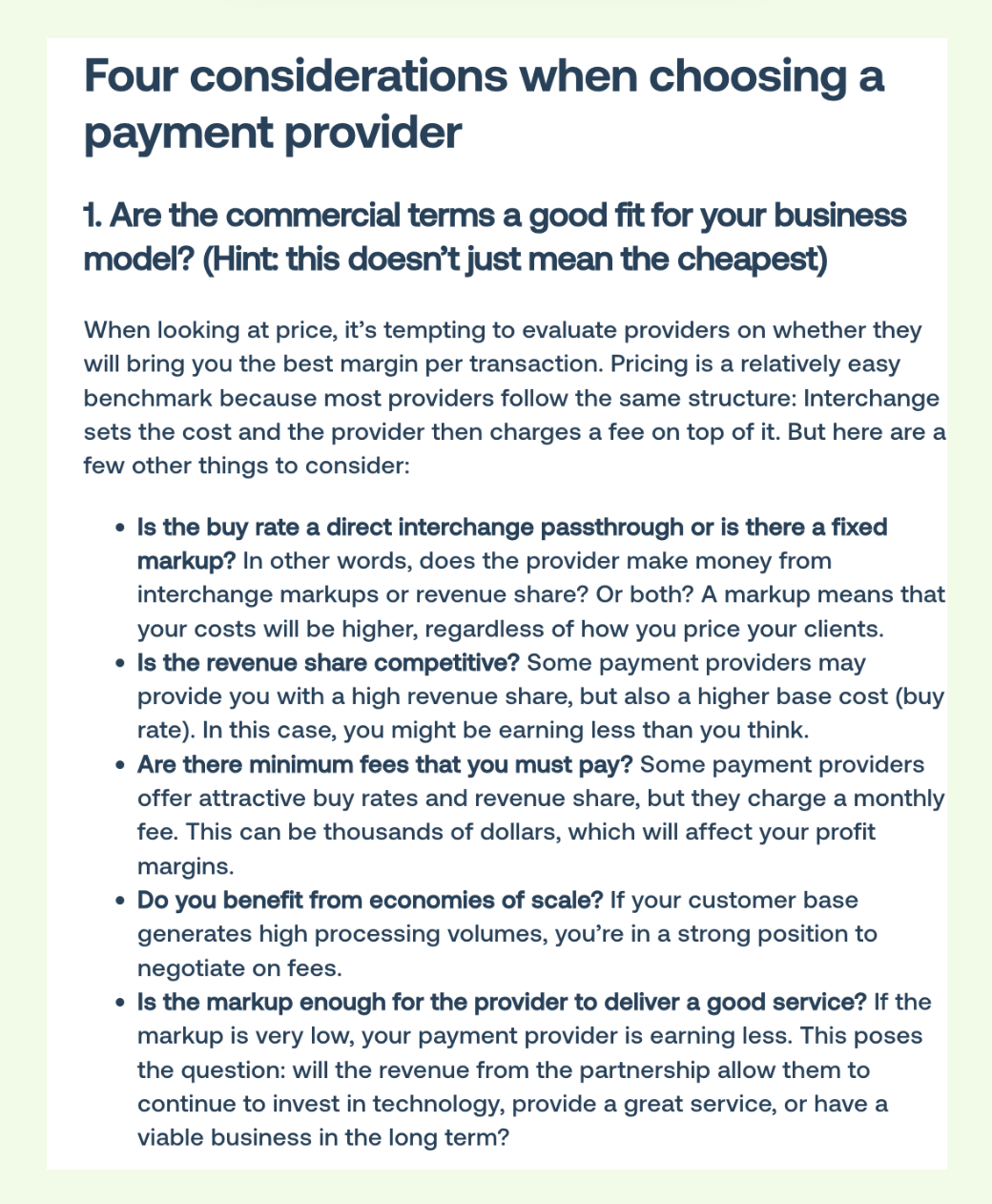
Why it works
- It leads with commercial levers, not features. The article starts by walking through real-world cost considerations—like markups, minimum fees, and revenue share—rather than opening with a product pitch. That approach builds trust and positions the content as a strategic resource.
- It gives the reader agency. By framing the content around questions (“Is the revenue share competitive?”), it invites the reader to reflect on their current setup. That makes the piece feel like a tool for decision-making rather than a sales funnel.
- It includes commercially relevant detail. Instead of vague advice, it breaks down common pricing structures and how different models impact margins. These specifics make the content more credible and useful to decision-makers.
What a great product section looks like
High-performing BOFU content doesn’t shy away from talking about the product. It introduces it at the right moment, once the broader strategy or solution has been laid out.
At this stage, the reader has likely bought into the general approach. They’re not looking for more context. They’re looking for clarity and a solution. A strong product section doesn’t feel like a pitch: it just feels like the natural next step.
This is where many writers hesitate, worried about coming across as too salesy. However, in the best BOFU content, the product section feels earned because it has already built empathy and trust by discussing the overall challenges, pain points, and problem-solving strategies.
The next example is from the same article as the last section: a piece about finding a payment provider as a SaaS.
Notice how, while the previous section provided a broad range of considerations you ought to know, this next section begins to spell out explicitly how our specific solution can help.
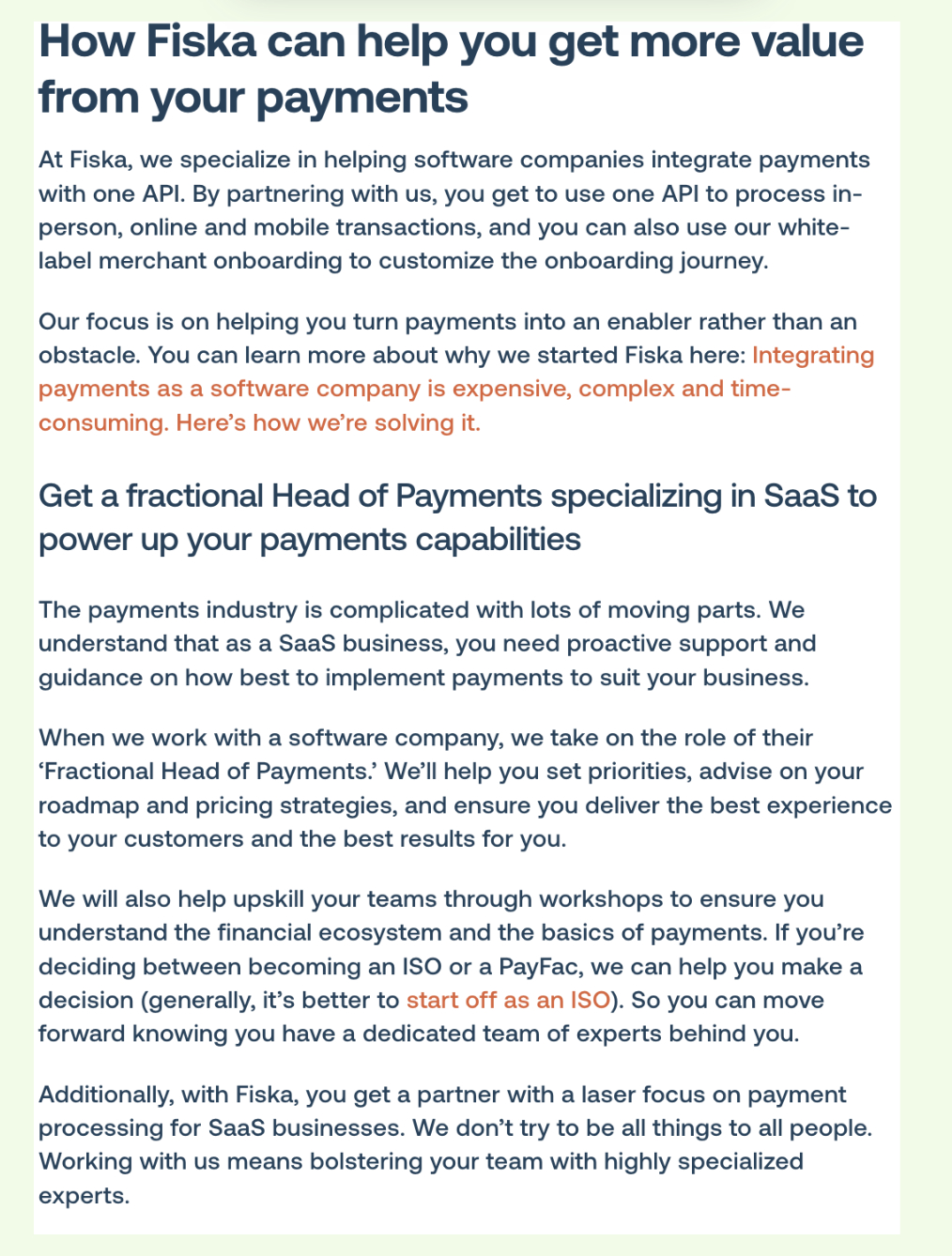
Why it works
- The product section feels earned. The piece starts by laying out a practical decision-making framework. By the time the product is introduced, the reader already understands the complexity involved. It’s not a pitch out of nowhere: it’s the logical next step. It also contains transparent information from an expert that is genuinely useful to the reader. Regardless of whether they choose our solution or not, we have built some credibility and trust. And when they do need us, we’ll have a leg up on the competition.
- It ties product features to business outcomes. Each feature is linked to something the reader cares about: faster time to market, lower costs, or more control. This makes it more persuasive for commercial decision-makers.
- It frames the product as a partner, not a vendor. The messaging focuses on guidance, flexibility, and long-term value. Framing Fiska as a ‘fractional Head of Payments’ gives weight to the support on offer and makes the proposition feel more strategic: which aligns exactly with what the reader (SaaS) is looking for.
Writing a great product section is an art in itself. Our founder, Araminta, has put together a helpful guide, with in-depth examples on how to effectively write about your product: How to Write About Your Product In Your Content [And Increase Conversions]
Examples of an effective closing section
Fortunately, the closing section is fairly simple. This is BOFU content, not a thriller. We’re not trying to throw in a twist at the last minute and leave the audience’s brains rattling.
The goal isn’t to surprise the reader or introduce new ideas here. It’s to briefly recap the core value of the article and point the reader to the next step.
Examples
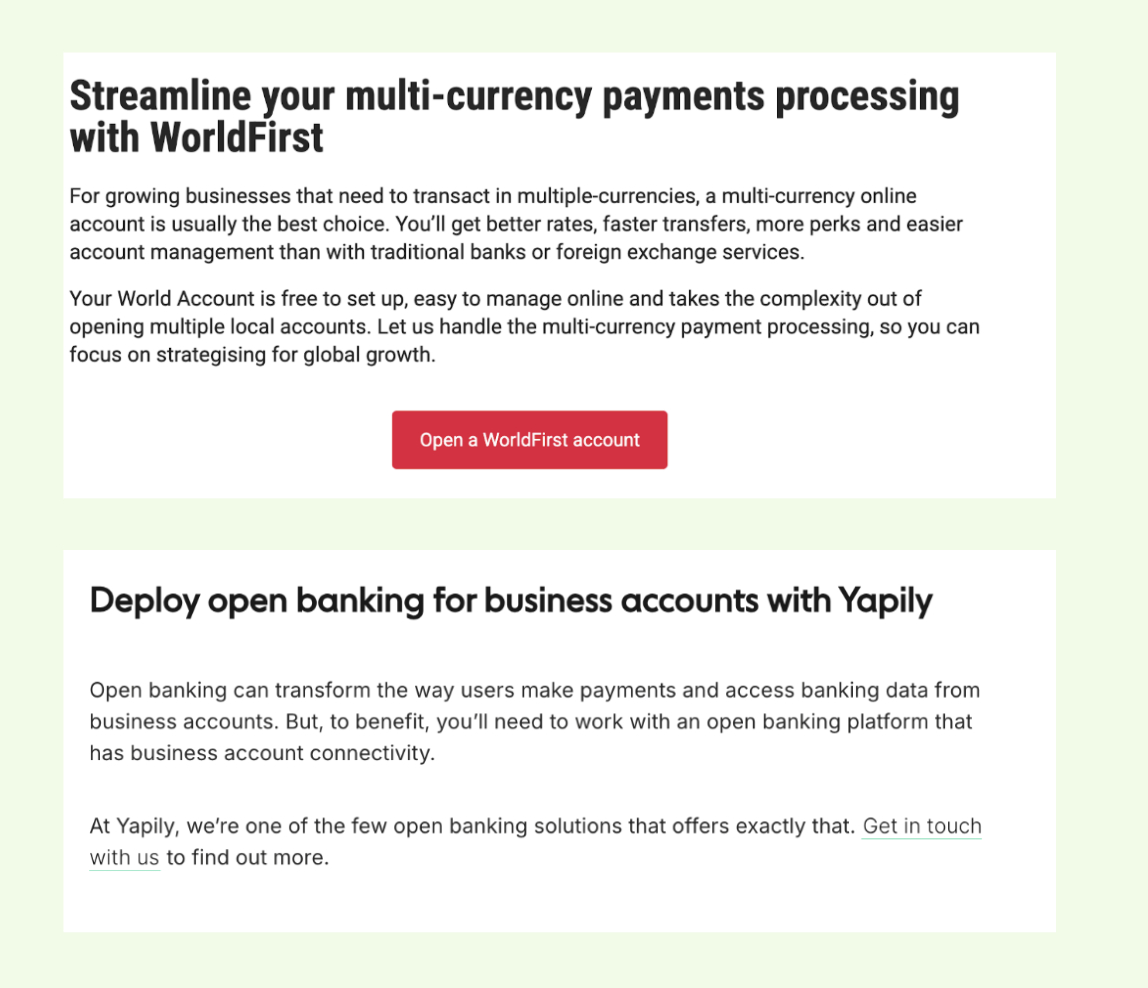
Why these examples work:
- It gets to the point. Keep it tight and focused. One or two sentences is usually enough.
- It doesn’t introduce new concepts. Everything in the summary should be a reinforcement, not a reveal.
- It includes a CTA. Whether that’s reading another piece, booking a demo, or downloading a resource, give the reader a clear action to take.
What we do at Mint Studios
At Mint Studios, we help leading fintechs and financial services companies turn content into customers.
We focus on bottom-of-funnel, expert-led content that speaks directly to high-intent buyers. Every piece is built around your product, strategy, and customers’ real questions, helping you rank in search, show up in AI tools, and win more deals. With our approach, we’ve been able to bring our clients' customers worth as much as $1 million.
For example, we helped Fintel Connect hit their lead goals within a year, generate enterprise-level leads (including a publicly listed company) and increase demo conversions by 29%. And all of this was through a single BOFU blog.








